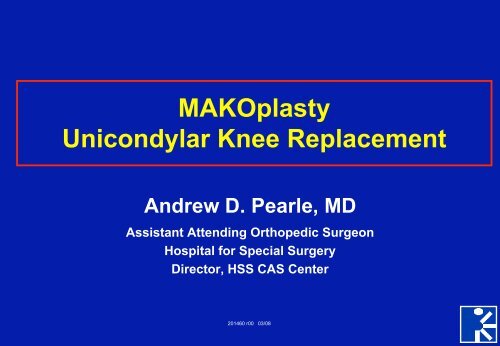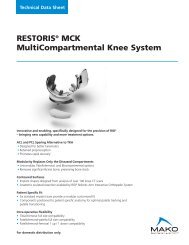Presentation by Andrew Pearle, M.D. - MAKO Surgical Corp.
Presentation by Andrew Pearle, M.D. - MAKO Surgical Corp.
Presentation by Andrew Pearle, M.D. - MAKO Surgical Corp.
You also want an ePaper? Increase the reach of your titles
YUMPU automatically turns print PDFs into web optimized ePapers that Google loves.
Computer Assisted SurgeryThe Big Picturepatientdiagnosispostoperativeevaluationpreoperativeplanning•Patient-Specific•MIS•Quantitativeintraoperativeexecution
Where are we going?Age of Quantitative Surgery• Technical Specifications for <strong>Surgical</strong> Procedures– What are the target specs– What are the tolerances of the specs– Are specs clinically relevant– Are CAOS tools reliable (accurate and precise)– Pitfalls• Price, increased surgical time, faulty data, etc
Rationale• Definite learning curve associated withperforming UKR– “Although TKA systems with good instrumentationmaybe implanted based on written instructions,UKA technique is best taught in the operatingroom”» Christensen CORR 1991• Implant positioning has effect on outcome inUKR– Coronal plane long leg alignment (avoid over andundercorrection)» Hernigou CORR 2004– Posterior slope of implant (avoid slope >7 deg)» Hernigou JBJS 2004– Varus angulation of tibial slope (attempt toreduce)» Engh J Arthroplasty 2006
Rationale• CAS techniques can improve positioning reliabilityin UKR and TKR• Ilsar, Joskowicz et al CAOS-International 2006– 139 clinical papers– Endpoint - 3 degrees from neutral alignment» Navigated TKR - 2130/2401 (89%)» Conventional TKR - 1325/1880 (71%)• Keene JBJS Br 2006– 20 navigated vs 20 conventional UKR; endpoint ± 2° of the preoperativeplan» Navigated UKR – 17/20 (87%)» Conventional UKR – 12/20 (60%)
Robotic Positioning: Principledrillimagesgoaldrillstartguidesurgeonrobotpatientplan
• Robotic arm actuallyperforms a surgicalact (or constrainsthe surgeon tomove in a region)• Surgeon-driven:<strong>MAKO</strong> bone surfacecutting in UKRRobotics:Execution Systems
<strong>MAKO</strong> Tactile Guidance System
<strong>MAKO</strong>plasty®• Inlay medial compartmentunicondylar knee resurfacing– “Serial prosthetic replacement”– Bone sparing• 3 mm tibial bone resected withpreservation of sclerotic bed(medial tibial buttress)and corticalrim• Technically challenging, jigless– Repicci Am J Knee Surg 2002• 96% success rate at 8 years
CT Based PlanningSegmentation3D model creation
CT Based Planning• Implant positioning– Alignment metrics– Visualization on 3D reconstruction of CT scan• Edge loading, congruence, preservation ofsubchondral sclerosis– Predicted (and intraoperative) gap kinematics• Targets, tolerances??
Pre-Op PlanningImplant positioning
<strong>MAKO</strong>plasty® Procedure• Register Robotic arm• 4.0 steiman pins for tibiaand femoral arrays• Medial parapatellarincision (2-4 inches)• Contact registration oftibia and femur• Jigless, robotic armassisted surgicalexecution
Pre-Op PlanningGap Kinematics
Intra-Op Execution
Intra-Op Execution
<strong>MAKO</strong>plasty®• n=140 procedures• 6 centers• No revisions
Quantitative SurgeryA fool with a tool is still a fool– Clinical judgment– <strong>Surgical</strong> indications– Soft tissue handlingChallenging to integrate quantitativefeedback with the art of surgery
Thank You
















